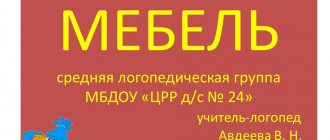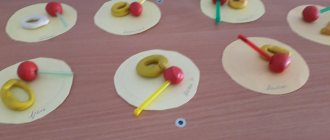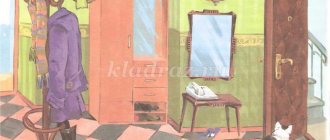Insert pictures
The insert picture is a picture with parts cut out. You need to find the missing pieces and put them in their places to create a complete image. For example, a drawing of a fruit bowl in which individual fruits are cut out. This game is intended for children from 2 to 4 years old. Its task can be expressed by the question “what is missing here?” Usually, children as young as two years old can easily cope with inserts, for example, with a row of vegetables and fruits or a row of dogs of the same shape, but of different sizes.
Thus, classes with insert pictures are very good for the formation and development of visual-figurative thinking that is just emerging in the baby.
It is necessary to choose insert pictures based on the age of the child: the younger he is, the fewer pieces should be cut out, and the larger the details.
In the simplest version of this game, the cut out fragment has smooth edges, and the design depicted on it is symmetrical (for example, a symmetrical daisy on a square piece). Or the shape of the piece matches the image: a cut out cup, saucer, spoon, etc. In these cases, in order to cope with the task, the child simply needs to understand which part of the picture this element is from. To complicate the task, you can offer your child a picture with uneven edges of the cutouts that do not coincide with the boundaries of the picture.
It is even more difficult for a child to cope with a picture, the cut-out parts of which have smooth edges, but the image located on them is asymmetrical: for example, a bird is drawn on a square - the child has to be careful not to put it upside down. Or each piece does not represent a separate image, but only a part of it, for example, a fragment of a vase or flower. Here the child is forced to focus on the shape of the cutout and the corresponding piece (we insert a circle into a round cutout, a triangle into a triangular cutout), and also take into account the content of what is drawn, correlate the details of the image, all the lines, colors and location of the drawing. These insert pictures are especially difficult for a child due to age characteristics, and at some stage he will need the help of an adult. However, such games prepare the basis for the successful development of visual and figurative thinking. The experience gained will allow the child to more easily cope with much more complex puzzles.
Cutting pictures
A cut picture is a picture cut along straight (usually) lines. The child does not have to think about the shape of the pieces and can focus on the image. This activity is good for children from 2 to 5 years old. The fact is that until a child is 5 years old, it is quite difficult for him to navigate according to two parameters at once - the shape of the pieces (the way the picture is cut) and the content (what is depicted). However, it is at this age that cut-out pictures most contribute to the development of visual-figurative thinking.
The simplest cut pictures are images of individual objects familiar to the child (bucket, house, butterfly), cut into two symmetrical parts. The difficulty of assembling the picture increases with the number of parts and with the appearance of the plot. Games with cut-out pictures bring great pleasure to kids. For example, a house divided into parts (“roof”, “wall”, “base”) can be “built”. Thanks to this game, the child develops concentration, observation, imagination, visual perception and develops holistic ideas about the subject.
When buying or making cut-out pictures yourself, you need to pay attention to the following points: the image in the picture must be recognizable (in this regard, for a European child, a bear is better than a rhinoceros, and a rhinoceros is better than a cuttlefish); the colors used in the drawing should be bright, but not irritating; the number of parts must be age appropriate.
Toys. “Fold the picture” lesson plan (junior group) on the topic
Topic: “Fold the picture”
Goal: Development of sensory perception in children.
Tasks:
Educational
- Strengthen children's knowledge about toys.
- Develop the ability to recognize the object shown in the picture, show it or name it (if possible).
- To develop the ability to identify objects by examining their shape.
- Develop the ability to piece together a whole.
Correctional and developmental
- Develop coordinated actions of the hand and eye through the ability to trace an image along the contour.
- Develop the ability to correlate a graphic image with a real object: “Take the same toy.”
- Develop communication skills with the help of the Masha doll.
Educational
- Cultivate a caring attitude towards toys.
- Encourage children to help each other as much as possible.
Age orientation: younger age.
Visual and didactic material: Subject pictures depicting toys, 2 pcs. (pyramid, bear, ball, matryoshka, bucket, tumbler, spinning top, car, airplane). Cut one in half vertically, the car, the plane - horizontally. One remains as a sample for selection. Toys - pyramid, bear, ball, matryoshka, bucket, tumbler, spinning top, car, airplane. Rubber balls of medium size according to the number of children.
Progress of the lesson
Organizing time
Children sit on chairs. Bring in a basket of toys.
Educator: Look what's in my basket?
The teacher shows each toy, names it, and places it on a bench in front of the children. Then he asks to repeat or show (depending on whether the child has speech). “Show me, Alyosha, the pyramid. What is this, Seryozha? etc.
Educator: In a word, these are pears. What is this? (children's answers - toys).
Game situation
There's a knock on the door. The teacher opens the door and brings the doll, speaking on behalf of himself and the doll.
Educator: The doll Masha came to visit us.
- Hello guys.
- Hello, Masha.
- Let's meet Masha.
The teacher brings the doll to each child and says on behalf of the doll, “My name is Masha.” Child: “My name is ... (pronounces the name, if he does not speak, the teacher pronounces the name for him), etc. Children shake hands with a doll.
Educator: Masha loves to communicate with children. Let's doll Masha study with us today.
Correctional and developmental block
Children sit in a semicircle at tables.
Educator: Look, Masha brought pictures with her. What is shown in the picture? That's right, Seryozha, a car!
The child, with the help of an adult, learns to trace the object shown in the picture, moving his finger along the outline, and so on with each child, offering new pictures.
Educator: Now we’ll play with you.
Game “Take the same toy.”
Children come up to the table one by one, take a picture (pictures lie on the table upside down), turn it over, name it and bring a toy, putting it in the basket. If the child does not speak, the teacher names the toy shown in the picture. The child brings a toy and puts it in the basket. The Masha doll “participates” in the game and completes the task. The teacher encourages the children and praises them.
Main job
The teacher shows the same pictures, but cut into halves. Explains that you need to correctly fold the picture so that you get a “whole pyramid”, “a whole car”, etc.
Fold the halves and find an identical image in the whole picture. Offer to put together the whole picture yourself. And so with every child.
Make the task more difficult.
Give each child 2 images and the children independently select the halves.
Doll Masha also puts together a “whole picture.”
Educator: Misha, did Masha put the halves together correctly?
Misha: No.
Educator: Help Masha, please. Well done, thank you for helping Masha.
(can be repeated 3-4 times with different children, the correct option is also played out).
Musical physical education minute
Educator: Guys, Masha has a surprise for us (bring in an opaque bag of balls). Let's guess what's in it ourselves (children feel the bag with their hands and call it “balls”).
The song “New Ball” performed by Maria Lukacs is played.
Words: Lorina Dymova
Music: Zinovy Kompaneets
The teacher takes the ball and plays with it while the music plays, the children repeat or play the ball on their own.
The final stage
Educator: Today we learned how to make a picture from halves. You did a great job, you worked hard, you were attentive - you recognized toys from pictures, helped Masha, and each other. Masha liked working with you, but other children are waiting for her.
Reflection
Children say goodbye to the doll Masha: “Goodbye!” Come to us again!” They hug her and stroke her.
Cubes
Composite pictures on cubes have their own peculiarity associated with the shape of the cube. A fragment located on each face is no longer just part of a flat image. To get the picture, it is not enough to put the cube in its place, it needs to be turned the right way. Composite pictures on the cubes suggest the presence of a basic understanding of the cube. This type of composite pictures fulfills its developmental task for children from 3-4 to 6-7 years old. You need to start your acquaintance with four cubes, on which there is an image of a separate object (fruit, dog, car, etc.). When offering a game, all the cubes need to be turned with one picture facing up - this simplifies the task, the baby just needs to place them in the correct order. As the child masters this game, the task needs to be complicated: first, turn one cube the wrong way and ask the child to find the missing part of the picture on it, then do the same with two cubes, with three. Gradually the child will get used to this game.
Now he can be offered a plot image in pictures (for example, a scene from a familiar fairy tale).
What are the benefits of cubes? Many of them are made in the same style, for example, on all sides there are scenes from fairy tales, and on three sides events taking place in the hut are depicted, and on the other three - in the forest; all sides are painted in the same color scheme. Therefore, sometimes it is not easy even for an adult to determine at first glance whether the cube is turned the right way. To avoid mistakes, you need to be very careful and patient.
Important points when choosing cubes: unity of style, color scheme, similarity of plot and age-appropriate level of difficulty. It is precisely these cubes that will most effectively fulfill their developmental task.
Didactic game “Collect a picture”
FAIRY TALES
Didactic game “COLLECT A PICTURE”
GAME FOR CHILDREN 3 – 7 years old
The game introduces the plots of Russian folk tales, develops active speech, memory, attention, imagination, and teaches how to compose a story from pictures.
GUIDELINES
- The game involves 1 – 2 people.
- For younger children, the game is led by an adult leader; after explaining the rules, older children can play independently.
- Before the game, introduce the children to the plots of the following fairy tales:
Kolobok, Ryabka Hen, Turnip, Three Bears, Zayushkina's Hut,
At the behest of the pike, The Tale of the Fisherman and the Fish, The Frog Princess, Geese
- swans...
Coping with the building. Help him if there is any difficulty.
The duration of the game depends on the child’s interest (10
- 15 minutes.).
LET'S GET TO KNOW TALES
OBJECTIVE OF THE GAME:
Introduce children to famous Russian folk
fairy tales
PROGRESS OF THE GAME:
The adult presenter tells or reads any of the fairy tales used in the game. Children try to remember the plot. Then the presenter lays out all the game cards face up on the table and asks you to find two pictures related to the plot of the fairy tale you heard.
When children become familiar with the plots of all fairy tales, they can move on to the next game.
NAME THE FAIRY TALE
OBJECTIVE OF THE GAME:
Teach children to guess and name fairy tales from pictures.
PROGRESS OF THE GAME:
The presenter shuffles all the cards and places them face up on the playing surface.
Players take turns taking one picture at a time and name the fairy tale to which it belongs. If the answer is correct, the player keeps the card. The one with the most cards at the end of the game wins.
COLLECT A TALE
OBJECTIVE OF THE GAME:
Teach children to find heroes of one fairy tale.
PROGRESS OF THE GAME:
The presenter places the cards face down, shuffles them and distributes them equally to the players. Participants turn over their cards and look for pairs of cards that match each other, on which characters from the same fairy tale are drawn. At the same time, the children tell what is shown on their cards and name the fairy tale. If players do not have enough cards, they turn over their “extra” card and exchange it for the “extra” card of the neighbor on the left.
The game ends when all players have collected a complete set of their cards.
TELL ME A STORY
OBJECTIVE OF THE GAME:
Teach your child to select cards related to one fairy tale and tell its plot.
PROGRESS OF THE GAME:
The presenter asks each player to choose a fairy tale to tell. Then he shuffles all the game cards and invites players to find the heroes of their fairy tale. The one who finds the necessary cards fastest is the first to start the story.


